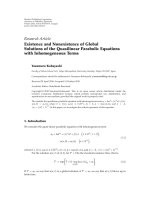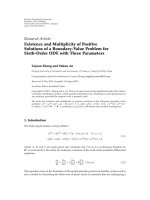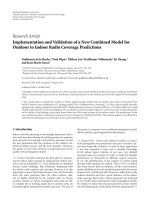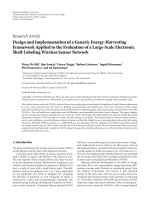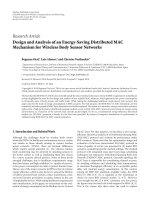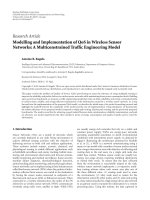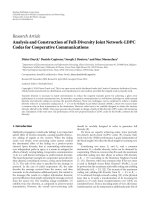Báo cáo hóa học: " Research Article Connectedness and Compactness of Weak Efficient Solutions for Set-Valued Vector " pptx
Bạn đang xem bản rút gọn của tài liệu. Xem và tải ngay bản đầy đủ của tài liệu tại đây (523.77 KB, 15 trang )
Hindawi Publishing Corporation
Journal of Inequalities and Applications
Volume 2008, Article ID 581849, 15 pages
doi:10.1155/2008/581849
Research Article
Connectedness and Compactness of
Weak Efficient Solutions for Set-Valued
Vector Equilibrium Problems
Bin Chen, Xun-Hua Gong, and Shu-Min Yuan
Department of Mathematics, Nanchang University, Nanchang 330047, China
Correspondence should be addressed to Xun-Hua Gong,
Received 1 November 2007; Revised 17 July 2008; Accepted 5 September 2008
Recommended by C. E. Chidume
We study the set-valued vector equilibrium problems and the set-valued vector Hartman-
Stampacchia variational inequalities. We prove the existence of solutions of the two problems.
In addition, we prove the connectedness and the compactness of solutions of the two problems in
normed linear space.
Copyright q 2008 Bin Chen et al. This is an open access article distributed under the Creative
Commons Attribution License, which permits unrestricted use, distribution, and reproduction in
any medium, provided the original work is properly cited.
1. Introduction
We know that one of the important problems of vector variational inequalities and vector
equilibrium problems is to study the topological properties of the set of solutions. Among
its topological properties, the connectedness and the compactness are of interest. Recently,
Lee et al. 1 and Cheng 2 have studied the connectedness of weak efficient solutions set
for single-valued vector variational inequalities in finite dimensional Euclidean space. Gong
3–5 has studied the connectedness of the various solutions set for single-valued vector
equilibrium problem in infinite dimension space. The set-valued vector equilibrium problem
was introduced by Ansari et al. 6. Since then, Ansari and Yao 7, Konnov and Yao 8,Fu
9, Hou et al. 10,Tan11, Peng et al. 12, Ansari and Flores-Baz
´
an 13,Linetal.14
and Long et al. 15 have studied the existence of solutions for set-valued vector equilibrium
and set-valued vector variational inequalities problems. However, the connectedness and the
compactness of the set of solutions to the set-valued vector equilibrium problem remained
unstudied. In this paper, we study the existence, connectedness, and the compactness of the
weak efficient solutions set for set-valued vector equilibrium problems and the set-valued
vector Hartman-Stampacchia variational inequalities in normed linear space.
2 Journal of Inequalities and Applications
2. Preliminaries
Throughout this paper, let X, Y be two normed linear spaces, let A be a nonempty subset of
X,letF : A × A → 2
Y
be a set-valued map, and let C be a closed convex pointed cone in Y .
We consider the following set-valued vector equilibrium problem SVEP:find
x ∈ A,
such that
F
x, y ∩ −int C∅ ∀y ∈ A. 2.1
Definition 2.1. Let int C
/
∅. Avectorx ∈ A satisfying
Fx, y ∩ −int C∅ ∀y ∈ A 2.2
is called a weak efficient solution to the SVEP. Denote by V
w
A, F the set of all weak efficient
solutions to the SVEP.
Let Y
∗
be the topological dual space of Y .Let
C
∗
{f ∈ Y
∗
: fy ≥ 0 ∀y ∈ C} 2.3
be the dual cone of C.
Definition 2.2. Let f ∈ C
∗
\{0}. A vector x ∈ A is called an f-efficient solution to the SVEP if
fFx, y ≥ 0 ∀y ∈ A, 2.4
where fFx, y ≥ 0 means that fz ≥ 0, for all z ∈ Fx, y. Denote by V
f
A, F the set of all
f-efficient solutions to the SVEP.
Definition 2.3. Let A be a nonempty convex subset in X. A set-valued map F : A × A → 2
Y
is called to be C-convex in its second variable if, for each fixed x ∈ A, for every y
1
,y
2
∈ A,
t ∈ 0, 1, the following property holds:
tFx, y
1
1 − tFx, y
2
⊂ Fx, ty
1
1 − ty
2
C. 2.5
Definition 2.4. Let A be a nonempty convex subset in X. A set-valued map F : A × A → 2
Y
is called to be C-concave in its first variable if, for each fixed y ∈ A, for every x
1
,x
2
∈ A,
t ∈ 0, 1, the following property holds:
Ftx
1
1 − tx
2
,y ⊂ tFx
1
,y1 − tFx
2
,yC. 2.6
Definition 2.5. Let A be a nonempty subset of X.LetT : A → 2
LX,Y
be a set-valued map,
where LX, Y is the space of all bounded linear operators from X into Y let LX, Y be
equipped with operator norm topology.SetTx,y{s, y : s ∈ Tx},x,y∈ A.
Bin Chen et al. 3
i Let A be a convex subset of X. T is said to be v-hemicontinuous if, for every pair of
points x, y ∈ A, the set-valued map
Jα :Tαy 1 − αx,y− x,α∈ 0, 1, 2.7
is lower semicontinuous at 0.
ii Let f ∈ C
∗
\{0}. T is said to be f-pseudomonotone on A if, for every pair of points
x, y ∈ A, fs, y − x ≥ 0, for all s ∈ Tx, then fs
,y− x ≥ 0, for all s
∈ Ty.
The definition of v-hemicontinuity was introduced by Lin et al. 14.
Definition 2.6. Let X be a Hausdorff topological vector space and let K ⊂ X be a nonempty
set. G : K → 2
X
is called to be a KKM map if for any finite set {x
1
, ,x
n
}⊂K the relation
co{x
1
, ,x
n
}⊂
n
i1
Gx
i
2.8
holds, where co{x
1
, ,x
n
} denoted the convex hull of {x
1
, ,x
n
}.
For the definition of the upper semicontinuity and lower semicontinuity, see 16.
The following FKKM theorem plays a crucial role in this paper.
Lemma 2.7. Let X be a Hausdorff topological vector space. Let K be a nonempty convex subset of X,
and let G : K → 2
K
be a KKM map. If for each x ∈ K, Gx is closed in X, and if there exists a point
x
0
∈ K such that Gx
0
is compact, then
x∈K
Gx
/
∅.
By definition, we can get the following lemma.
Lemma 2.8. Let A be a nonempty convex subset of X.LetF : A × A → 2
Y
be a set-valued map, and
let C ⊂ Y be a closed convex pointed cone. Moreover, suppose that Fx, y is C-convex in its second
variable. Then, for each x ∈ A, Fx, AC is convex.
3. Scalarization
In this section, we extend a result in 3 to set-valued map.
Theorem 3.1. Suppose that int C
/
∅, and that Fx, AC is a convex set for each x ∈ A.Then
V
w
A, F
f∈C
∗
\{0}
V
f
A, F. 3.1
Proof. It is clear that
V
w
A, F ⊃
f∈C
∗
\{0}
V
f
A, F. 3.2
4 Journal of Inequalities and Applications
Now we prove that
V
w
A, F ⊂
f∈C
∗
\{0}
V
f
A, F. 3.3
Let x ∈ V
w
A, F. By definition, Fx, y ∩ −int C∅, for all y ∈ A.Thus
Fx, A ∩ −int C∅. 3.4
As C is a convex pointed cone, we have
Fx, AC ∩ −int C∅. 3.5
By assumption, Fx, AC is a convex set. By the separation theorem of convex sets, there
exist some f ∈ Y
∗
\{0}, such that
inf{fFx, yc : y ∈ A, c ∈ C}≥sup{f−c : c ∈ C}. 3.6
By 3.6,weobtainthatf ∈ C
∗
\{0} and
fFx, y ≥ 0 ∀y ∈ A. 3.7
Therefore, x ∈ V
f
A, F. Hence V
w
A, F ⊂
f∈C
∗
\{0}
V
f
A, F. Thus we have
V
w
A, F
f∈C
∗
\{0}
V
f
A, F. 3.8
4. Existence of the weak efficient solutions
Theorem 4.1. Let A be a nonempty closed convex subset of X and let C ⊂ Y be a closed convex
pointed cone with int C
/
∅.LetF : A × A → 2
Y
be a set-valued map with Fx, x ⊂ C for all x ∈ A.
Suppose that for each y ∈ A, F·,y is lower semicontinuous on A, and that Fx, y is C-convex
in its second variable. If there exists a nonempty compact subset D of A, and y
∈ D, such that
Fx, y
∩ −int C
/
∅, for all x ∈ A \ D, then, for any f ∈ C
∗
\{0}, V
f
A, F
/
∅, V
f
A, F ⊂ D,
V
w
A, F
/
∅, and V
w
A, F ⊂ D.
Proof. Let f ∈ C
∗
\{0}. Define the set-valued map G : A → 2
A
by
Gy{x ∈ A : fFx, y ≥ 0},y∈ A. 4.1
By assumption, y ∈ Gy, for all y ∈ A,soGy
/
∅. We claim that G is a KKM map.
Suppose to the contrary that there exists a finite subset {y
1
, ,y
n
} of A, and there exists
Bin Chen et al. 5
x ∈ co{y
1
, ,y
n
} such that x
/
∈
n
i1
Gy
i
. Then x
n
i1
t
i
y
i
for some t
i
≥ 0, 1 ≤ i ≤ n,with
n
i1
t
i
1, and x
/
∈ Gy
i
, for all i 1, ,n. Then there exist z
i
∈ Fx, y
i
, such that
fz
i
< 0 ∀i 1, ,n. 4.2
As Fx, y is C-convex in its second invariable, we can get that
t
1
Fx, y
1
t
2
Fx, y
2
··· t
n
Fx, y
n
⊂ Fx, xC. 4.3
By 4.3, we know that there exist z ∈ F
x, x, c ∈ C, such that
t
1
z
1
t
2
z
2
···t
n
z
n
z c. 4.4
Hence fz cft
1
z
1
t
2
z
2
···t
n
z
n
. By assumption, we have fz c ≥ 0. By 4.2,
however, we have ft
1
z
1
t
2
z
2
···t
n
z
n
< 0. This is a contradiction. Thus G is a KKM map.
Now we show that for each y ∈ A, Gy is closed. For any sequence, {x
n
}⊂Gy and x
n
→ x
0
.
Because A is a closed set, we have x
0
∈ A. By assumption, for each y ∈ A, F·,y is lower
semicontinuous on A, then by 16, for each fixed y ∈ A, and for each z
0
∈ Fx
0
,y, there
exist z
n
∈ Fx
n
,y, such that z
n
→ z
0
. Because {x
n
}⊂Gy, we have
fFx
n
,y ≥ 0. 4.5
Thus fz
n
≥ 0. By the continuity of f and z
n
→ z
0
, we have fz
0
≥ 0. By the arbitrariness
of z
0
∈ Fx
0
,y, we have fFx
0
,y ≥ 0, that is, x
0
∈ Gy. Hence Gy is closed. By the
assumption, we have Gy
⊂ D,andGy
is closed. Since D is compact, Gy
is compact.
By Lemma 2.7, we have
y∈A
Gy
/
∅. Thus there exists x ∈
y∈A
Gy. This means that
fFx, y ≥ 0 ∀y ∈ A. 4.6
Therefore, x ∈ V
f
A, F. Next we show that V
f
A, F ⊂ D.Ifx ∈ V
f
A, F, then x ∈
y∈A
Gy ⊂ Gy
⊂ D. It follows from V
f
A, F ⊂ V
w
A, F that V
w
A, F
/
∅,andby
Theorem 3.1, we have V
w
A, F ⊂ D.
Theorem 4.2. Let A be a nonempty closed convex subset of X and let C ⊂ Y be a closed convex
pointed cone with int C
/
∅.Letf ∈ C
∗
\{0}. Assume that T : A → 2
LX,Y
is a v-hemicontinuous,
f-pseudomonotone mapping. Moreover, assume that the set-valued map F : A × A → 2
Y
defined by
Fx, yTx,y− x is C-convex in its second variable. If there exists a nonempty compact subset D
of A, and y
∈ D, such that Tx,y
− x ∩ −int C
/
∅, for all x ∈ A \ D,thenV
f
A, F
/
∅ and
V
f
A, F ⊂ D.
Proof. Let f ∈ C
∗
\{0}. Define the set-valued maps E, G : A → 2
A
by
Ey{x ∈ A : fs, y − x ≥ 0 ∀s ∈ Tx},y∈ A,
Gy{x ∈ A : fs, y − x ≥ 0 ∀s ∈ Ty},y∈ A,
4.7
6 Journal of Inequalities and Applications
respectively. As for each y ∈ A, we have y ∈ Ey, then Ey
/
∅. The proof of the theorem is
divided into four steps.
I E is a KKM map on A.
Suppose to the contrary that there exists a finite subset {y
1
, ,y
n
} of A, and there
exists
x ∈ co{y
1
, ,y
n
} such that x
/
∈
n
i1
Ey
i
. Then x ∈ A, x
n
i1
t
i
y
i
for some t
i
≥ 0,
1 ≤ i ≤ n,with
n
i1
t
i
1, and x
/
∈ Ey
i
, for all i 1, ,n. Then there exist s
i
∈ T x such that
fs
i
,y
i
− x < 0 for each i 1, 2, ,n. 4.8
Since Fx, y is C-convex in its second variable, we have
t
1
T x, y
1
− x··· t
n
T x, y
n
− x ⊂ T x, x − xC C. 4.9
Let z
i
s
i
,y
i
− x, for each i 1, 2, ,n.By4.9, we know there exists c ∈ C, such that
t
1
z
1
t
2
z
2
··· t
n
z
n
c. 4.10
As f ∈ C
∗
\{0}, we have
fc ≥ 0. 4.11
While by 4.8, we have ft
1
z
1
t
2
z
2
··· t
n
z
n
< 0. This is a contraction. Hence E is a KKM
map on A.
II Ey ⊂ Gy for all y ∈ A and G is a KKM map.
By the f-pseudomonotonicity of T, for each y ∈ A, we have Ey ⊂ Gy. Since E is a
KKM map, so is G.
III
y∈A
Gy
/
∅.
Now we show that for each y ∈ A, Gy is closed. Let {x
n
} be a sequence in Gy such
that x
n
converges to x. By the closedness of A, we have x ∈ A. Since {x
n
}⊂Gy, then for
each s ∈ Ty, we have
fs, y − x
n
≥ 0. 4.12
As x
n
→ x, and the continuity of f, then for each s ∈ Ty, we have
fs, y − x ≥ 0. 4.13
Consequently, x ∈ Gy. Hence Gy is closed. By the assumption, we have Gy
⊂ D. Then
Gy
is compact since D is compact. By step II,weknowG is a KKM map. By Lemma 2.7,
y∈A
Gy
/
∅.
IV
y∈A
Gy
y∈A
Ey.
Because Ey ⊂ Gy, we have
y∈A
Gy ⊃
y∈A
Ey. Now let us show that
y∈A
Gy ⊂
y∈A
Ey.Letx ∈
y∈A
Gy. For each y ∈ A, and each s ∈ Ty, we have
fs, y −
x ≥ 0. 4.14
Bin Chen et al. 7
For any s ∈ T
x and for each fixed y ∈ A, define the set-valued mapping J : 0, 1 → 2
Y
by
JαTαy 1 − α
x,y− x α ∈ 0, 1. 4.15
We pick a sequence {α
n
}⊂0, 1 such that α
n
→ 0andsetx
n
α
n
y 1 − α
n
x. Since A is a
convex set, x
n
∈ A for each n. It is clear that x
n
→ x.Letw s, y−x. We have w ∈ J0. Since
T is v-hemicontinuous, Jα is lower semicontinuous at 0. By 16, there exist w
n
∈ Jα
n
Tα
n
y 1 − α
n
x, y − x, such that w
n
→ w.Asw
n
∈ Jα
n
, there exist s
n
∈ Tx
n
such that
w
n
s
n
,y− x.Byw
n
→ w, we have s
n
,y− x → s, y − x.By4.14, we have
α
n
fs
n
,y− x fs
n
,α
n
y 1 − α
n
x − x ≥ 0. 4.16
Since α
n
> 0, fs
n
,y − x ≥ 0. Hence fs, y − x ≥ 0sincef is continuous and w
n
→ w.
Therefore, for any s ∈ T
x and for each y ∈ A, we have fs, y − x ≥ 0. Hence x ∈
y∈A
Ey.
Thus
y∈A
Ey
y∈A
Gy
/
∅. This means that there exists x ∈ A, for each s ∈ Tx, we have
fs, y − x ≥ 0, for all y ∈ A. It follows that x ∈ V
f
A, F,thusV
f
A, F
/
∅. By the proof of
Theorem 4.1,weknowV
f
A, F ⊂ D. Since V
f
A, F ⊂ V
w
A, F, we have V
w
A, F
/
∅.The
proof of the theorem is completed.
5. Connectedness and compactness of the solutions set
In this section, we discuss the connectedness and the compactness of the weak efficient
solutions set for set-valued vector equilibrium problems and the set-valued vector Hartman-
Stampacchia variational inequalities in normed linear space.
Theorem 5.1. Let A be a nonempty closed convex subset of X,letC ⊂ Y be a closed convex pointed
cone with int C
/
∅, and let F : A×A → 2
Y
be a set-valued map. Assume that the following conditions
are satisfied:
i for each y ∈ A, F·,y is lower semicontinuous on A;
ii Fx, y is C-concave in its first variable and C-convex in its second variable;
iii Fx, x ⊂ C, for all x ∈ A;
iv {Fx, y : x, y ∈ A} is a bounded subset in Y ;
v there exists a nonempty compact convex subset D of A, and y
∈ D, such that Fx, y
∩
−int C
/
∅, for all x ∈ A \ D.
Then V
w
A, F is a nonempty connected compact set.
Proof. We define the set-valued map H : C
∗
\{0}→2
D
by
HfV
f
A, F,f∈ C
∗
\{0}. 5.1
By Theorem 4.1, for each f ∈ C
∗
\{0}, we have Hf
/
∅, hence V
w
A, F
/
∅ and V
w
A, F ⊂
D. It is clear that C
∗
\{0} is convex, so it is a connected set. Now we prove that, for each
f ∈ C
∗
\{0}, Hf is a connected set. Let x
1
,x
2
∈ Hf, we have x
1
,x
2
∈ D and
fFx
i
,y ≥ 0 ∀y ∈ A. 5.2
8 Journal of Inequalities and Applications
Because Fx, y is C-concave in its first variable, for each fixed y ∈ A, and for above x
1
,x
2
∈
D,andt ∈ 0, 1, we have tx
1
1 − tx
2
∈ D since D is convex, and
Ftx
1
1 − tx
2
,y ⊂ tFx
1
,y1 − tFx
2
,yC. 5.3
Hence for each y ∈ A, z ∈ Ftx
1
1 − tx
2
,y, there exist z
1
∈ Fx
1
,y, z
2
∈ Fx
2
,y,and
c ∈ C, such that z tz
1
1 − tz
2
c.Asf ∈ C
∗
\{0} and by 5.2, we have
fztfz
1
1 − tfz
2
fc ≥ 0. 5.4
Thus
fFtx
1
1 − tx
2
,y ≥ 0 ∀y ∈ A, 5.5
that is tx
1
1 − tx
2
∈ Hf.SoHf is convex, therefore it is a connected set.
Now we show that Hf is upper semicontinuous on C
∗
\{0}. Since D is a nonempty
compact set, by 16, we only need to prove that H is closed. Let the sequence {f
n
,x
n
}⊂
GraphH and f
n
,x
n
→ f
0
,x
0
, where {f
n
} converge to f
0
with respect to the norm
topology. As f
n
,x
n
∈ GraphH, we have
x
n
∈ Hf
n
V
f
n
A, F, 5.6
that is, f
n
Fx
n
,y ≥ 0, for all y ∈ A.Asx
n
→ x
0
and D is compact, we have x
0
∈ D. Since for
each y ∈ A, F·,y is lower semicontinuous on A, for each fixed y ∈ A, and each z
0
∈ Fx
0
,y,
there exist z
n
∈ Fx
n
,y, such that z
n
→ z
0
.Fromf
n
Fx
n
,y ≥ 0, we have
f
n
z
n
≥ 0. 5.7
By the continuity of f
0
and z
n
→ z
0
, we have
f
0
z
n
−→ f
0
z
0
. 5.8
Let Q {Fx, y : x, y ∈ A}. By assumption, Q is a bounded set in Y , then there exist some
M>0, such that for each z ∈ Q, we have z≤M. For any ε>0, because f
n
− f
0
→ 0with
respect to norm topology, there exists n
0
∈ N, and when n ≥ n
0
, we have f
n
− f
0
<ε.
Therefore, there exists n
0
∈ N, and when n ≥ n
0
, we have
|f
n
z
n
− f
0
z
n
| |f
n
− f
0
z
n
|≤f
n
− f
0
z
n
≤Mε. 5.9
Hence
lim
n →∞
f
n
z
n
− f
0
z
n
0. 5.10
Bin Chen et al. 9
Consequently, by 5.8, 5.10, we have
lim
n →∞
f
n
z
n
lim
n →∞
f
n
z
n
− f
0
z
n
f
0
z
n
lim
n →∞
f
n
z
n
− f
0
z
n
lim
n →∞
f
0
z
n
f
0
z
0
.
5.11
By 5.7, we have f
0
z
0
≥ 0. So for any y ∈ A and for each z
0
∈ Fx
0
,y, we have f
0
z
0
≥ 0.
Hence
f
0
Fx
0
,y ≥ 0 ∀y ∈ A. 5.12
This means that
x
0
∈ V
f
0
A, FHf
0
. 5.13
Hence the graph of H is closed. Therefore, H is a closed map. By 16, H is upper
semicontinuous on C
∗
\{0}. Because Fx, y is C-convex in its second variable, by Lemma 2.8,
for each x ∈ A, Fx, AC is convex. It follows from Theorem 3.1 that
V
w
A, F
f∈C
∗
\{0}
V
f
A, F. 5.14
Thus by 17, Theorem 3.1 V
w
A, F is a connected set.
Now, we show that V
w
A, F is a compact set. We first show that V
w
A, F is a
closed set. Let {x
n
}⊂V
w
A, F with x
n
→ x
0
. Since D is compact, x
0
∈ D. We claim that
x
0
∈ V
w
A, F. Suppose to the contrary that x
0
/
∈ V
w
A, F, then there exist some y
0
∈ A such
that
Fx
0
,y
0
∩ −int C
/
∅. 5.15
Thus there exists z
0
∈ Fx
0
,y
0
such that
z
0
∈−int C. 5.16
Hence −int C is a neighborhood of z
0
. Since F·,y
0
is lower semicontinuous at x
0
, there exists
some neighborhood Ux
0
of x
0
such that
Fx, y
0
∩ −int C
/
∅ ∀x ∈ Ux
0
∩ A. 5.17
Since x
n
→ x
0
, there exist some n
0
, and when n ≥ n
0
, we have x
n
∈ Ux
0
∩ A.By5.17,
Fx
n
,y
0
∩ −int C
/
∅. 5.18
10 Journal of Inequalities and Applications
This contradicts {x
n
}⊂V
w
A, F.Thusx
0
∈ V
w
A, F. This means that V
w
A, F is a closed
set. Since D is compact and V
w
A, F ⊂ D, V
w
A, F is compact.
Theorem 5.2. Let A be a nonempty closed convex subset of X, and let C ⊂ Y be a closed convex
pointed cone with int C
/
∅. Assume that for each f ∈ C
∗
\{0}, T : A → 2
LX,Y
is a v-hemicontinuous,
f-pseudomonotone mapping. Moreover, assume that the set-valued map F : A × A → 2
Y
defined by
Fx, yTx,y − x is C-convex in its second variable, and the set {Fx, y : x, y ∈ A} is a
bounded set in Y. If there exists a nonempty compact convex subset D of A, and y
∈ D, such that
Tx,y
− x ∩ −int C
/
∅, for all x ∈ A \ D,thenV
w
A, F is a nonempty connected set.
Proof. We define the set-valued map H : C
∗
\{0}→2
D
by
HfV
f
A, F for each f ∈ C
∗
\{0}. 5.19
By Theorem 4.2, for each f ∈ C
∗
\{0}, we have HfV
f
A, F
/
∅ and V
f
A, F ⊂ D. Hence
V
w
A, F
/
∅ and V
w
A, F ⊂ D. Clearly, C
∗
\{0} is a convex set, hence it is a connected set.
Define the set-valued maps E, G : A → 2
A
by
Ey{x ∈ A : fs, y − x ≥ 0, ∀s ∈ Tx},y∈ A,
Gy{x ∈ A : fs, y − x ≥ 0, ∀s ∈ Ty},y∈ A,
5.20
respectively. Now we prove that for each f ∈ C
∗
\{0}, Hf is a connected set. Let x
1
,x
2
∈
HfV
f
A, F, then x
1
,x
2
∈
y∈A
Ey. By the proof of Theorem 4.2, we have
y∈A
Gy
y∈A
Ey,sox
1
,x
2
∈
y∈A
Gy. Hence f or i 1, 2, and for each y ∈ A, s ∈ Ty, we have
fs, y − x
i
≥ 0. 5.21
Then, for each y ∈ A, s ∈ Ty,andt ∈ 0, 1, we have tx
1
1 − tx
2
∈ D since D is convex and
fs, y − tx
1
1 − tx
2
≥ 0. 5.22
Hence tx
1
1 − tx
2
∈
y∈A
Gy
y∈A
Ey.Thustx
1
1 − tx
2
∈ Hf. Consequently,
for each f ∈ C
∗
\{0}, Hf is a convex set. Therefore, it is a connected set. The following is
to prove that H is upper semicontinuous on C
∗
\{0}. Since D is a nonempty compact set, by
16 we only need to show that H is a closed map. Let sequence {f
n
,x
n
}⊂GraphH and
f
n
,x
n
→ f
0
,x
0
, where {f
n
} converges to f
0
with respect to the norm topology of Y
∗
.As
f
n
,x
n
∈ GraphH, we have
x
n
∈ Hf
n
V
f
n
A, F. 5.23
Then, for each s
∈ Tx
n
, we have that
f
n
s
,y− x
n
≥ 0 ∀y ∈ A. 5.24
Bin Chen et al. 11
By assumption, for each n, T : A → 2
LX,Y
is f
n
-pseudomonotone, and by 5.24, for each
y ∈ A, for the above x
n
, and for each s ∈ Ty, we have
f
n
s, y − x
n
≥ 0 ∀y ∈ A. 5.25
As x
n
→ x
0
, we have s, y − x
n
→ s, y − x
0
,andf
0
s, y − x
n
→ f
0
s, y − x
0
.Asx
n
→ x
0
,
and D is compact, we have x
0
∈ D.LetQ {Fx, y : x, y ∈ A}. By assumption, Q is a
bounded set in Y. Then, there exists M>0, such that for each z ∈ Q, we have z≤M. For
any ε>0, because f
n
− f
0
→ 0 with respect to the norm topology, there exists n
0
∈ N,and
when n ≥ n
0
, we have f
n
− f
0
<ε. Therefore, there exists n
0
∈ N, and when n ≥ n
0
,we
have
|f
n
s, y − x
n
− f
0
s, y − x
n
| |f
n
− f
0
s, y − x
n
|≤Mε. 5.26
Hence
lim
n →∞
f
n
s, y − x
n
− f
0
s, y − x
n
0. 5.27
Then
lim
n →∞
f
n
s, y − x
n
lim
n →∞
f
n
s, y − x
n
− f
0
s, y − x
n
f
0
s, y − x
n
f
0
s, y − x
0
.
5.28
Then, by 5.25, 5.28, we have f
0
s, y − x
0
≥ 0. Hence for each y ∈ A, and for each s ∈ Ty,
we have f
0
s, y − x
0
≥ 0. Since T is f
0
-pseudomonotone, for each y ∈ A, and for each
s
∗
∈ Tx
0
, we have f
0
s
∗
,y − x
0
≥ 0. Hence x
0
∈ Hf
0
V
f
0
A, F. Therefore, the graph
of H is closed, and H is a closed map. By 16,weknowthatH is upper semicontinuous on
C
∗
\{0}. Because Fx, y is C-convex in its second variable, for each x ∈ A, Fx, AC is
convex. It follows from Theorem 3.1 that
V
w
A, F
f∈C
∗
\{0}
V
f
A, F. 5.29
Then, by 17, Theorem 3.1, we know that V
w
A, F is a connected set. The proof of the
theorem is completed.
Let N
b
0 denote the base of neighborhoods of 0 of LX, Y .By18, for each bounded
subset Q ⊂ X, and for each neighborhood V of 0 in Y , we have
WQ, V : {s ∈ LX, Y : sQ ⊂ V }∈N
b
0. 5.30
Lemma 5.3. Let A be a nonempty convex subset of X, and let T : A → 2
LX,Y
. If T is lower
semicontinuous on A,thenT is v-hemicontinuous on A.
12 Journal of Inequalities and Applications
Proof. For any fixed x, y ∈ A, we need to show that the set-valued mapping
Jα :Tαy 1 − αx,y− x,α∈ 0, 1, 5.31
is lower semicontinuous at 0. For any z ∈ J0 and for any neighborhood Uz of z, there
exists s
0
∈ Tx such that z s
0
,y− x, and there exists a neighborhood V of 0 in Y , such that
Uzz V . Since T is lower semicontinuous at x, f or the neighborhood
Us
0
: s
0
Wy − x, V s
0
{s ∈ LX, Y : s, y − x ∈ V } 5.32
of s
0
, there exists a neighborhood Ux of x such that
Tx
∩ Us
0
/
∅ ∀x
∈ Ux ∩ A. 5.33
For the above y,sinceαy 1 − αx → x, when α → 0, there exists 0 <α
0
< 1, and when
0 <α<α
0
, we have αy 1 − αx ∈ Ux. By 5.33, we have
Tαy 1 − αx ∩ Us
0
/
∅ ∀0 <α<α
0
. 5.34
Thus there exist s
α
∈ Tαy 1 − αx such that s
α
∈ Us
0
, for all 0 <α<α
0
.By5.32,we
have
s
α
,y− x ∈ Uz ∀0 <α<α
0
, 5.35
that is
Jα ∩ Uz
/
∅ ∀0 ≤ α<α
0
. 5.36
This means that J is lower semicontinuous at 0. By definition, T is v-hemicontinuous on
A.
Theorem 5.4. Let A be a nonempty closed bounded convex subset of X, and let C ⊂ Y be a closed
convex pointed cone with int C
/
∅. Assume that for each f ∈ C
∗
\{0}, T : A → 2
LX,Y
is a f-
pseudomonotone, lower semicontinuous mapping. Moreover, assume that the set-valued map F : A ×
A → 2
Y
defined by Fx, yTx,y − x is C-convex in its second variable, and the set {Fx, y :
x, y ∈ A} is a bounded set in Y. If there exists a nonempty compact convex subset D of A, and
y
∈ D, such that Tx,y
− x ∩ −int C
/
∅, for all x ∈ A \ D,thenV
w
A, F is a nonempty
connected compact set.
Proof. By Lemma 5.3 and Theorem 5.2, V
w
A, F is a nonempty connected set. Since D is a
compact set, we need only to show that V
w
A, F is closed. Let {x
n
}⊂V
w
A, F,x
n
→ x
0
. It
is clear that x
0
∈ D and {x
n
}⊂D. We claim that x
0
∈ V
w
A, F. Suppose to the contrary that
x
0
/
∈ V
w
A, F, then there exists y
0
∈ A such that
Fx
0
,y
0
∩ −int C
/
∅, 5.37
Bin Chen et al. 13
that is
Tx
0
,y
0
− x
0
∩ −int C
/
∅. 5.38
Thus there exists s
0
∈ Tx
0
such that
s
0
,y
0
− x
0
∈−int C. 5.39
Hence there exists ε>0 such that
s
0
,y
0
− x
0
εB ⊂−int C, 5.40
where B is the unit ball of Y .Set
W
y
0
− A,
ε
2
B
s ∈ LX, Y : s, y
0
− A ⊂
ε
2
B
. 5.41
By definition, Wy
0
− A, ε/2B is a neighborhood of zero of LX, Y,sinceA is bounded.
Since T is lower semicontinuous at x
0
, for the above s
0
∈ Tx
0
and the above Wy
0
−A, ε/2B,
there exists a neighborhood Ux
0
of x
0
such that
Tx ∩
s
0
W
y
0
− A,
ε
2
B
/
∅ ∀x ∈ Ux
0
∩ A. 5.42
Since x
n
→ x
0
, there exists N such that when n ≥ N, we have x
n
∈ Ux
0
. Thus by 5.42 we
have
Tx
n
∩
s
0
W
y
0
− A,
ε
2
B
/
∅. 5.43
Thus there exist s
n
∈ Tx
n
∩ s
0
Wy
0
− A, ε/2B, for all n ≥ N. We have s
n
− s
0
∈
Wy
0
− A, ε/2B, and hence
s
n
− s
0
,y
0
− A ⊂
ε
2
B. 5.44
Therefore,
s
n
− s
0
,y
0
− x
n
∈
ε
2
B ∀ n ≥ N. 5.45
14 Journal of Inequalities and Applications
Since x
n
→ x
0
and s
0
∈ LX, Y , we have s
0
,x
0
− x
n
→ 0. Hence t here exists N
1
≥ N,and
when n ≥ N
1
, we have s
0
,x
0
− x
n
∈ ε/2B. This combining 5.45 implies that
s
n
,y
0
− x
n
− s
0
,y
0
− x
0
s
n
,y
0
− x
n
− s
0
,y
0
− x
n
s
0
,y
0
− x
n
− s
0
,y
0
− x
0
s
n
− s
0
,y
0
− x
n
s
0
,x
0
− x
n
∈
ε
2
B
ε
2
B εB ∀n ≥ N
1
.
5.46
Hence
s
n
,y
0
− x
n
∈ s
0
,y
0
− x
0
εB ∀n ≥ N
1
. 5.47
By 5.40 and 5.47, we have
s
n
,y
0
− x
n
∈−int C ∀ n ≥ N
1
. 5.48
On the other hand, since {x
n
}⊂V
w
A, F, we have
Tx
n
,y− x
n
∩ −int C∅ ∀y ∈ A, ∀n. 5.49
This contradicts 5.48, because s
n
∈ Tx
n
. Thus x
0
∈ V
w
A, F. This means that V
w
A, F is a
closed subset of X.
Acknowledgments
This research was partially supported by the National Natural Science Foundation of China
and the Natural Science Foundation of Jiangxi Province, China.
References
1 G. M. Lee, D. S. Kim, B. S. Lee, and N. D. Yen, “Vector variational inequality as a tool for studying
vector optimization problems,” Nonlinear Analysis: Theory, Methods & Applications, vol. 34, no. 5, pp.
745–765, 1998.
2 Y. Cheng, “On the connectedness of the solution set for the weak vector variational inequality,” Journal
of Mathematical Analysis and Applications, vol. 260, no. 1, pp. 1–5, 2001.
3 X H. Gong, “Efficiency and Henig efficiency for vector equilibrium problems,” Journal of Optimization
Theory and Applications, vol. 108, no. 1, pp. 139–154, 2001.
4 X H. Gong, W. T. Fu, and W. Liu, “Super efficiency for a vector equilibrium in locally convex
topological vector spaces,” in Vector Variational Inequalities and Vector Equilibria, F. Giannessi, Ed.,
vol. 38 of Nonconvex Optimization and Its Applications, pp. 233–252, Kluwer Academic Publishers,
Dordrecht, The Netherlands, 2000.
5 X H. Gong, “Connectedness of the solution sets and scalarization for vector equilibrium problems,”
Journal of Optimization Theory and Applications, vol. 133, no. 2, pp. 151–161, 2007.
6 Q. H. Ansari, W. Oettli, and D. Schl
¨
ager, “A generalization of vectorial equilibria,” Mathematical
Methods of Operations Research, vol. 46, no. 2, pp. 147–152, 1997.
7 Q. H. Ansari and J C. Yao, “An existence result for the generalized vector equilibrium problem,”
Applied Mathematics Letters, vol. 12, no. 8, pp. 53–56, 1999.
8 I. V. Konnov and J. C. Yao, “Existence of solutions for generalized vector equilibrium problems,”
Journal of Mathematical Analysis and Applications, vol. 233, no. 1, pp. 328–335, 1999.
Bin Chen et al. 15
9 J Y. Fu, “Generalized vector quasi-equilibrium problems,” Mathematical Methods of Operations
Research, vol. 52, no. 1, pp. 57–64, 2000.
10 S. H. Hou, H. Yu, and G. Y. Chen, “On vector quasi-equilibrium problems with set-valued maps,”
Journal of Optimization Theory and Applications, vol. 119, no. 3, pp. 485–498, 2003.
11 N. X. Tan, “On the existence of solutions of quasivariational inclusion problems,” Journal of
Optimization Theory and Applications, vol. 123, no. 3, pp. 619–638, 2004.
12 J W. Peng, H W. J. Lee, and X M. Yang, “On system of generalized vector quasi-equilibrium
problems with set-valued maps,” Journal of Global Optimization, vol. 36, no. 1, pp. 139–158, 2006.
13 Q. H. Ansari and F. Flores-Baz
´
an, “Recession methods for generalized vector equilibrium problems,”
Journal of Mathematical Analysis and Applications, vol. 321, no. 1, pp. 132–146, 2006.
14 L J. Lin, Q. H. Ansari, and Y J. Huang, “Some existence results for solutions of generalized vector
quasi-equilibrium problems,” Mathematical Methods of Operations Research, vol. 65, no. 1, pp. 85–98,
2007.
15 X J. Long, N J. Huang, and K L. Teo, “Existence and stability of solutions for generalized strong
vector quasi-equilibrium problem,” Mathematical and Computer Modelling, vol. 47, no. 3-4, pp. 445–
451, 2008.
16 J P. Aubin and I. Ekeland, Applied Nonlinear Analysis, Pure and Applied Mathematics, John Wiley &
Sons, New York, NY, USA, 1984.
17 A. R. Warburton, “Quasiconcave vector maximization: connectedness of the sets of Pareto-optimal
and weak Pareto-optimal alternatives,” Journal of Optimization Theory and Applications, vol. 40, no. 4,
pp. 537–557, 1983.
18 A. P. Robertson and W. Robertson, Topological Vector Spaces, Cambridge Tracts in Mathematics and
Mathematical Physics, no. 53, Cambridge University Press, New York, NY, USA, 1964.



